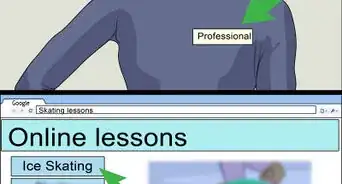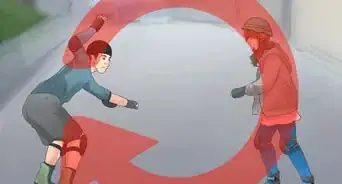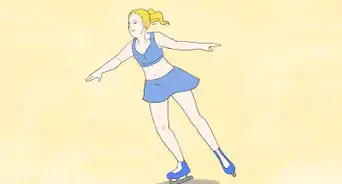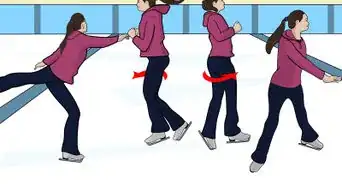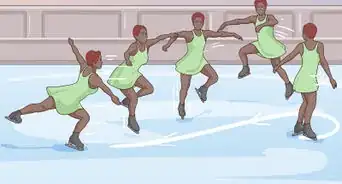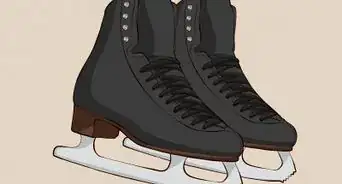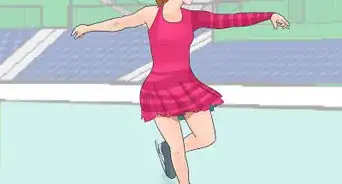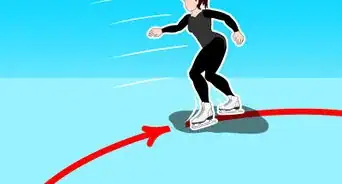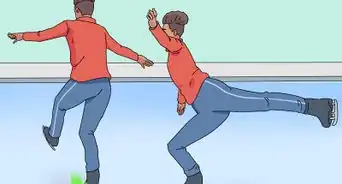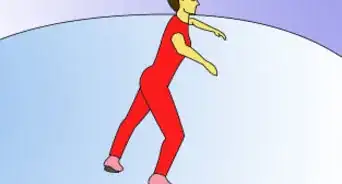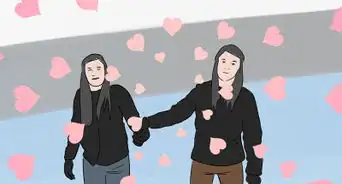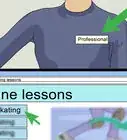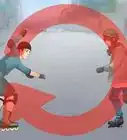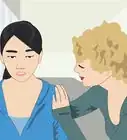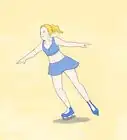X
wikiHow is a “wiki,” similar to Wikipedia, which means that many of our articles are co-written by multiple authors. To create this article, 28 people, some anonymous, worked to edit and improve it over time.
This article has been viewed 122,853 times.
Learn more...
How many times have you said to yourself: "I can do it, today I am going to skate!", just to fall on your bottom and give up? Learning to skate will take some perseverance but you can do it. All you need to do is master some basic skills and then you'll be ready for the fancy looking stuff before you know it.
Steps
Part 1
Part 1 of 3:
Building Your Skills
-
1Gear up. Before you get out on the ice, you need to put on your skates. Don't worry about buying your own gear right away. You can rent your gear until you're sure you want to figure skate for a long time. Remember to dress warmly! Gloves and scarves are good.[1]
- Make sure you rent skates that fit. They should feel very snug but you should be able to wiggle your toes, just not too much and you don't want your skates to hurt your feet or make them tingle.
- You'll also want to be sure you lace them tight enough. You should not be able to roll your ankle. Your skates should fit like a glove.
-
2Learn how to fall. The very first thing you should learn as a figure skater is how to fall. You will fall a lot and it's important to know how to fall so that you don't hurt yourself. Practice falling. If you feel like you're about to fall, squat down so that when you land, your bottom or sides absorb the shock of the fall instead of something that can break or be seriously injured. Do not land with your hands out. Doing this can cause damage to your wrist, as well as let an unaware skater skate over your fingers.[2]
- You should also learn how to get up or at least get out of the way quickly. You don't want other people to run in to you.
Advertisement -
3Loosen your knees. The next thing that you should practice as a figure skater is how to keep your knees nice and loose. When you're new to skating, you'll be unstable on your legs and your muscles will be weak, so you'll naturally want to keep your knees locked and stiff. However, loose knees that can move easily are very important for figure skating, not just allowing you to move but also keeping your legs from getting sore.
- Practice letting your muscles relax and shake your leg around. You can also get your knees loose by crouching just a very small amount.
-
4Learn how to move forward. Now that you can stand on skates comfortably and safely, you can learn how to move forward on skates. With one leg pointed forward, push your other leg back and out to the side very gently, with your toes angled away from your body just a little bit. This back leg should push you along the ice. Bring the back leg back down and then make the same push but with the other leg.
- Though the way you balance is different, you might want to learn this basic motion on street rollerblades before learning it on the ice. It is easier and can help keep you from hurting yourself.
-
5Learn how to stop. Of course, once you move forward, eventually you're going to want to stop. You can't just run into the wall forever! The most basic stop is done by bending your knees just a little and the leaning your body to the side, so that both of your blades are angled away from the direction you're moving in.
- You can also do a T stop, which is done by turning one of your blades into a T shape with the other blade and angling it away from the direction you're moving in.[3]
-
6Learn how to stroke. With those basic motions under your belt, you'll want to learn how to do a basic forward stroke. Stroking is when you do the same motions for moving forward, but longer and more gracefully. Do a more dramatic push off with your leg and hold that leg out behind you for longer before switching to the other leg.[4]
- Practice this to get to a point where it looks graceful and natural. This will be the basic movement between all of the tricks and movements you will do when figure skating, so you want to do it well.
Advertisement
Part 2
Part 2 of 3:
Learning the Basic Moves
-
1Learn how to move backwards. The very first "move" you will learn as a figure skater will almost always be how to move backwards. This is a lead in to many figure skating elements and is an important skill to learn and master. It takes coordination and practice but be patient: you'll get it.
- For the basics on how to move backwards, imagine reversing the motions of moving forward. With your weight on one foot, make a motion with your other foot like you're drawing a lemon in the ice, pushing yourself backwards and you round the curve of the "lemon".
-
2Learn how to turn. Making sharp turns, or even just the gentle turn of the skating rink, is an important skill for a figure skater. Another early skill you will learn is how to do slightly more complex ways of making turns than the simple way you probably learned on your own.There are two common methods for doing turns that you will learn early on:
- Forward crossovers are used for making large turns and building up momentum for jumps. Essentially, you will make the same motions that you do to move forward, but your legs will cross each other, slowly turning you. You can also do this same move backwards, although you should start with the forward movement.
- The three turn is another method of turning, used for doing sharp turns and changes of direction. This is more complex but still very doable for a beginner.
-
3Try learning spins. There are many different kinds of spins in figure skating and several of them are not as hard as they look. You'll probably be ready to do spins after about a year's worth of mastering the other moves.
- A basic spin is done by spinning in a circle in one place.
- A camel spin is done by spinning with one leg and your upper body parallel to the ice.
-
4Learn basic sequences. There are some series of movements or tricks that are standard in figure skating. This is called footwork and usually consists of a set of turns, spins, and jumps. Different sequences have different names and you'll want to learn some of the most basic sequences.
- Examples include the mohawk and the waltz three turn.
Advertisement
Part 3
Part 3 of 3:
Honing Your Skills
-
1Get comfortable. You'll want to work to be comfortable with all of the basic skating movements. Every time you learn a new motion, take a lot of time to do it before moving on to a new motion. This will let your muscles form "memories" about how to move that way, making it easier for you to make those motions without thinking about it. This is necessary for doing many complex tricks, since you can't always think about every little motion you make.
-
2Build your muscles and get in good shape. You'll need to be strong and healthy if you want to be good and feel comfortable when you figure skate. Get lots of exercise, try not to sit around and watch television all day, and eat plenty of healthy food.
- Your body will need lots of protein in order to work well while you skate. Try to eat protein that doesn't have a lot of fat, like turkey, fish, or nuts, so that your body doesn't feel weighed down.
-
3Get a coach or lessons. A coach or lessons might seem expensive, but it makes a huge difference in getting your skills built up. A coach will be able to see what you do wrong and help you fix your mistakes. They'll also be able to teach you new skills and tricks, helping you to become the best figure skater you can be.
-
4Practice, practice, practice. Practice. And then practice some more. Figure skating is a hard skill to learn. If it was easy, everyone would do it. That means that if you want to get good, or even just be okay, you'll need to figure skate a lot. It will take time to get to where you want to be and there are no tricks around it. You just have to work hard. You can do it!
- With weekly practice lasting several hours, you can get good enough to do basic figure skating in about a year or two. Daily practice over many years is needed to reach a competition-level of skill.
Advertisement
Community Q&A
-
QuestionShould I wear snow pants on my first try?
 Community AnswerI wouldn't do that since snow pants could restrict your movement and make it more difficult to skate.
Community AnswerI wouldn't do that since snow pants could restrict your movement and make it more difficult to skate. -
QuestionWhat exercises should I do to work on my balance?
 Community AnswerIf you improve your core, your balance will be improved. Do core exercises like sit-ups, scissors, planks, crunches, etc. 4-5 times a week and you'll notice a difference in no time.
Community AnswerIf you improve your core, your balance will be improved. Do core exercises like sit-ups, scissors, planks, crunches, etc. 4-5 times a week and you'll notice a difference in no time. -
QuestionAt what age should I start thinking about trying out figure skating?
 Community AnswerThe younger, the better. Skills develop more rapidly the younger you begin practicing them.
Community AnswerThe younger, the better. Skills develop more rapidly the younger you begin practicing them.
Advertisement
Things You'll Need
- Ice rink.
- Proper clothing.
- Someone to help you.
References
- ↑ https://www.parentmap.com/article/tips-for-teaching-kids-to-ice-skate
- ↑ https://www.parentmap.com/article/tips-for-teaching-kids-to-ice-skate
- ↑ https://www.myactivesg.com/Sports/Ice-Skating/Training-Method/Ice-Skating-for-Beginners/How-do-I-stop-while-ice-skating
- ↑ http://iceskatingresources.org/ForwardStroking.pdf
About This Article
Advertisement
-Step-1.webp)
-Step-2.webp)
-Step-3.webp)
-Step-4.webp)
-Step-5.webp)
-Step-6.webp)
-Step-7.webp)
-Step-8.webp)
-Step-9.webp)
-Step-10.webp)
-Step-11.webp)
-Step-12.webp)
-Step-13.webp)
-Step-14.webp)
